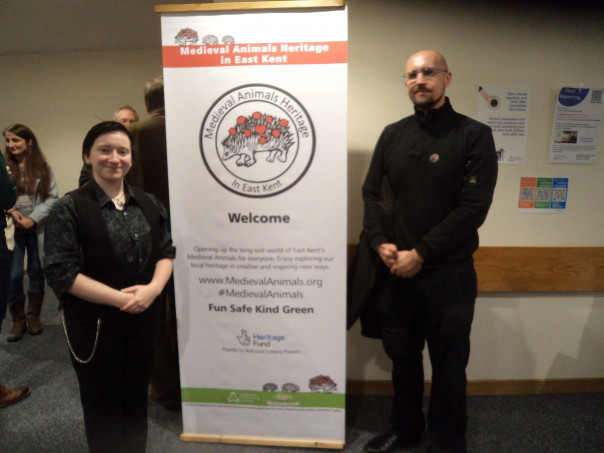Before I get to Professor Ken Dark’s KAS/CKHH lecture and the Kent History Postgraduates catch-up meeting, I thought I would draw your attention to the ‘Church, Saints and Seals, 1150–1300’ study day at Canterbury Cathedral on Saturday 11 March. For as well as hearing talks from distinguished speakers such as Professor Sandy Heslop in the morning, there will be a chance to visit both the Cathedral Archives and Conservation Studio. If this sounds of interest to you, please see: https://www.canterbury-cathedral.org/what-s-on/events/11march23-church-saints-and-seals-1150-1300/ for details and how to book.
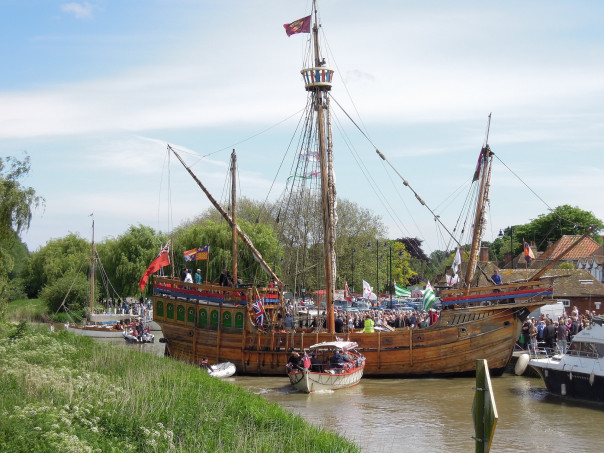
Having caught up with Dr Diane Heath this week, I thought I would report that she and her team of volunteers, with the assistance of John Hills and the gardening team at CCCU, will be back working on the Green Dragons in the Becket Garden very shortly. Additionally, Diane has more ‘Medieval Animals Heritage’ events for SEND children and their families planned for the next six months. These will include a visit to the cathedral archives to look at large images of medieval animals projected onto the ceiling while learning about them and the theme of ‘Medieval Animals’ for Canterbury’s Medieval Pageant in early July. If you would like to find out more, please see: Welcome To Medieval Animals | Our project focuses on the rich diversity of East Kent Medieval Animals Heritage (MAH) that spans nearly a thousand years.
Moreover, for other projects involving people from CKHH, for the Janus Foundation-funded ‘Kent’s Maritime Communities’ project with Dr Craig Lambert at the University of Southampton, we are putting together a book proposal that is provisionally entitled, ‘Across the Narrow Sea: Kent’s Links with Europe, c.1450-c.1640’. Regarding the research from The National Archives, much of this for the Elizabethan and early Stuart periods focuses on the Port Books, consequently if you don’t know about these great primary sources, you might be interested in Craig’s blog for his other current maritime project: Maritime Britain – The Crows Nest where he discusses such sources.
Furthermore, the allied Lossenham Project wills group met online again this week. I could only join the second half of the meeting, but it was obvious from that part of the discussion that members have been exploring potential topics they might write on for a series of short articles. Additionally, through their continuing work on the probate materials for parishes in the Rother Levels, the group is exploring early modern Kentish vocabulary relating to clothing and fabrics, a time when the range of fabrics was increasing markedly. If you are interested in finding out more about the Lossenham Project, please see: The Lossenham Project where there is a monthly newsletter among other items. And as well, there is another group who are engaged in my latest series of palaeography workshops under the auspices of KAS.
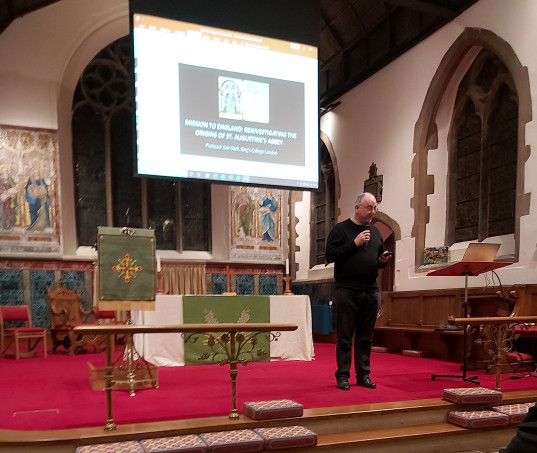
Returning now to Professor Dark’s lecture, a large audience had gathered in St Paul’s church, Canterbury, before Professor Kerry Brown, as President of Kent Archaeological Society, introduced Ken Dark. He began his talk by providing some background information about the late Roman period and the importance of Byzantine rule and cultural influence on Italy and north Africa in the early 6th century, for he sees Augustine’s mission to Anglo-Saxon England as coming out of this context. Turning next to where Berth,a as a Christian Merovingian lady, worshipped after her marriage to Aethelberht had brought her to Kent, he sees St Martin’s as the mostly likely place, and he supports the proposition that the building was probably a re-purposed Roman mausoleum. The idea that it was Bertha’s church before 597 is generally agreed, the case strengthened by the finding of her chaplain Liudhard’s pendant, but the latter proposal has some critics, instead seeing it as having been constructed as a chapel for the use of Bertha and her entourage.
Looking next at the St Augustine’s Abbey site, as at St Martin’s, there has been little recent archaeological work, albeit Professor Dark has found surveys in the English Heritage archive which had seemingly been ‘lost’ and he has now incorporated these findings into his published analysis. Thus his ‘Mission to England’ project, begun in 2018, is drawing on these surveys, as well as the notes from archaeological excavations undertaken in the late 19th and early 20th centuries and those from the 1950s and 1970s. In addition, Professor Dark has compiled a detailed photographic record of the surviving structures, especially the chapel of St Pancras as he and his team seek to reinvestigate the early history of the abbey site after Augustine’s arrival and establishment of the first monastery in Anglo-Saxon England.
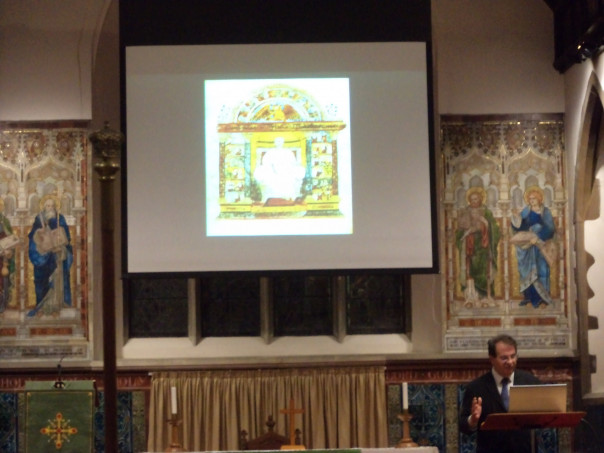
This brought Professor Dark to the major section of his lecture where he discussed the phasing of the chapel of St Pancras, seeing it as separate from the church dedicated to SS Peter and Paul and that to St Mary because they are on the same but on a different axis to that of St Pancras. His assessment of this latter chapel rests on matters such as the reuse of Roman brick for certain elements, the difference in the colour of the mortar indicative of different phasing, the presence/absence of specific decorative features in association with particular parts of the building, the range of stone used and a few dating features such as an 8th-century coin. Taking all of these together, he has concluded that the chapel should be seen as having been constructed in two distinct phases, it having gone out of use between Phase 1 and Phase 2, that Phase 2 consists of two sub-phases 2a and 2b, and that part of the Phase 1 structure was still standing when Phase 2 was begun because some of the first was incorporated into the second. Putting all of this together, he sees Phase 2 as late 7th to early 8th century. However, it is the dating of Phase 1 that he especially wanted to highlight to the audience. His argument is that the builders of Phase 1 used the short perch system of measurement, which Professor John Blair sees as an Anglo-Saxon not Merovingian construction method – that used the long perch system, and thus it must post-date Augustine’s arrival. Furthermore, as he explained to his audience, the more elaborate churches on the abbey site on their differently aligned axis come after 609, which means Phase 1 must date from 597 x 609. As he said, he has discussed this in more detail in an article published last year in the Journal of the British Archaeological Association, which is available to download through the Open Access scheme.
Moreover, his project has further objectives and amongst these he will be leading a team of archaeologists and volunteers to re-excavate part of the church of SS Peter and Paul in August 2023. This will involve taking out the gravel from around the tombs of the early archbishops and bishops, detailed surveying and the production of a photographic record, as well as radiocarbon dating some samples. The archaeologists will also re-investigate the Jenkins archive of the earlier excavations, thereby bringing together all that is known about the site. As he said, he is looking for local people to get involved and will be recruiting volunteers soon – a fantastic opportunity for students!

To finish off his lecture, he mentioned two other things that he wants to investigate – a pillar on the abbey site – where did it come from, how long has it been in its present position, does it pre-date the abbey, what might it have been for? His other fascination is the campanile mound. Ok as a place for the monastic belltower but was it there before the monastery, what is under it, can the archaeologists ‘peel back’ the layers and if so, was it much smaller in Anglo-Saxon times, and even could it be a ship burial? All of this is tantalising and exciting. In the meantime if you would like to read Professor Dark’s article, please see: https://centaur.reading.ac.uk/106464/ and from the audience’s reaction, it was clear that people had been fascinated, something that was similarly evident from the Q&A session afterwards.
For the final section this week, I want to bring you the Kent History Postgraduates’ catch-up session, not least because we were joined by Drs Lily Hawker-Yates and Dean Irwin whom we haven’t seen since the 2022 Medieval Canterbury Weekend. As founder members of the group, it seemed only fair to start by asking them how they are getting on in the ‘world after PhD’. Lily spoke first and following spells at several archaeological units, most recently undertaking public engagement activities linked to archaeological excavations for the HS2 project that involved TV filming for ‘Digging for Britain’ with Alice Roberts, she is now working for MOLA. This involves doing a wide range of social media activities, as well as organising an exhibition in London that will be opening in March. She is also thinking about a book proposal from her thesis.
Dean’s book proposal is coming along nicely, and he is also busy writing articles, as well as leading a very popular short online course on ‘The Jews of Medieval England’ with Professor Miri Rubin that has attendees from around the world. The article he is writing currently is taking him into the late Middle Ages, although certainly no later than 1485, and he’ll be back in the 13th century shortly! Like Dr Leonie Hicks (Canterbury Christ Church University), he’ll be speaking at the ‘Castles’ symposium at Winchester in June. Thus, it was great to hear that both Dean and Lily are getting on extremely well.

Grace spoke next and she is busy editing her literature review, as well as drawing together her research work with volunteers on the CITiZAN project based around the archaeological discoveries concerning fish traps in Sandwich Bay. She, too, is linked to MOLA and going forward this will involve the ‘Coasts in Mind’ project. For the next stage of her project, she is planning the best way to conduct interviews with volunteers engaged in the dig near Dover, and she recently attended the KAS Fieldwork conference as one of the Student Ambassadors.
Kaye similarly enjoyed being part of this research culture, and she too has been writing research papers, specifically on the Dering family. For the next stage, she intends to focus on the local community, exploring servants, households and neighbourhood which will involve primary sources such as records from secular and church courts. As she said, neighbourliness as a research theme is generating a growing historiography. For early modern Kent, among those who have examined such ideas are Professor Catherine Richardson and Drs Paula Simpson and Melanie Caiazza.
As well as starting to write her thesis chapter on founders and benefactors at her three religious houses, Jane has been studying Tonbridge Priory’s landholdings in the Leigh area. These holdings were apparently gathered piecemeal in the 13th century, something seen elsewhere in Kent for other religious houses, and it has given her the chance to explore ideas about networking through witness lists and others named in the documents. Furthermore, these records are valuable concerning locating these holdings in the landscape, and she may have also found a Jew who converted to Christianity – Dean is going to help here.
Maureen, too, has started writing and hopes to organise a zoom meeting with Janet soon in response to Janet’s very interesting presentation last time. She will also be joining Jane to visit The National Archives in the near future.
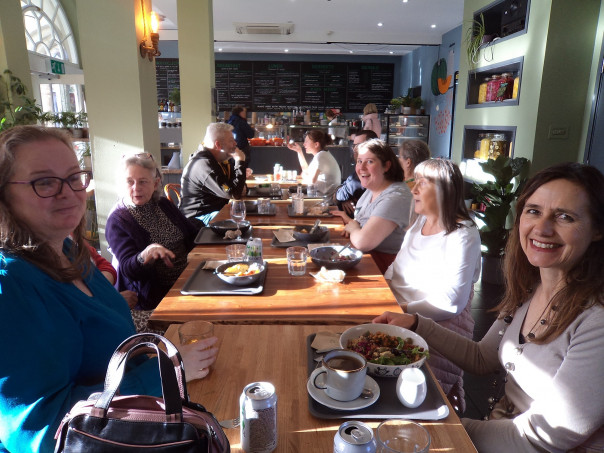
Janet, being much closer to completion, is currently editing her husbandry chapter. Among the topics she is interested in currently is medieval market gardening, including the cultivation of fruit. For while there is evidence for such activities on the manorial demesne lands in documents such as beadles’ rolls, finding references to this among the peasantry is far harder to find for north-west Kent.
Tracey has similarly been exploring landholding for the High Middle Ages. Her area of interest is to the east of Canterbury and the roles women from knightly families undertook in the development of several small lay manors. Like Janet, she is keen to draw on archaeological as well as documentary evidence, and if matters work out, she may have significantly more of this than she had expected.
In our catch up, Kieron was the final postgraduate. She is busy compiling her literature review and is drafting the section on towns with special reference to their relations with the Crown. Working on Tudor Dover, she is also engaged in various outreach initiatives involving the Maison Dieu, and because of the structural work going on there, this will mean holding workshops at Dover Museum. Allied to her activities at Dover, she has joined the KAS Maritime Kent steering group.
Consequently, as I hope you can see the KHP continues to be a very active forum, part of the university’s research culture that provides a great space for postgraduates to engage with their peers and explore new ideas and approaches.
 Centre for Kent History and Heritage
Centre for Kent History and Heritage Sheila Sweetinburgh
Sheila Sweetinburgh 1119
1119